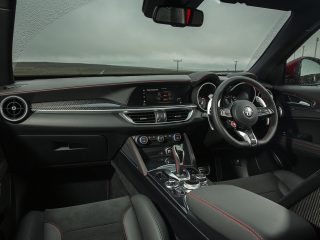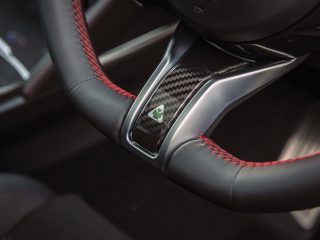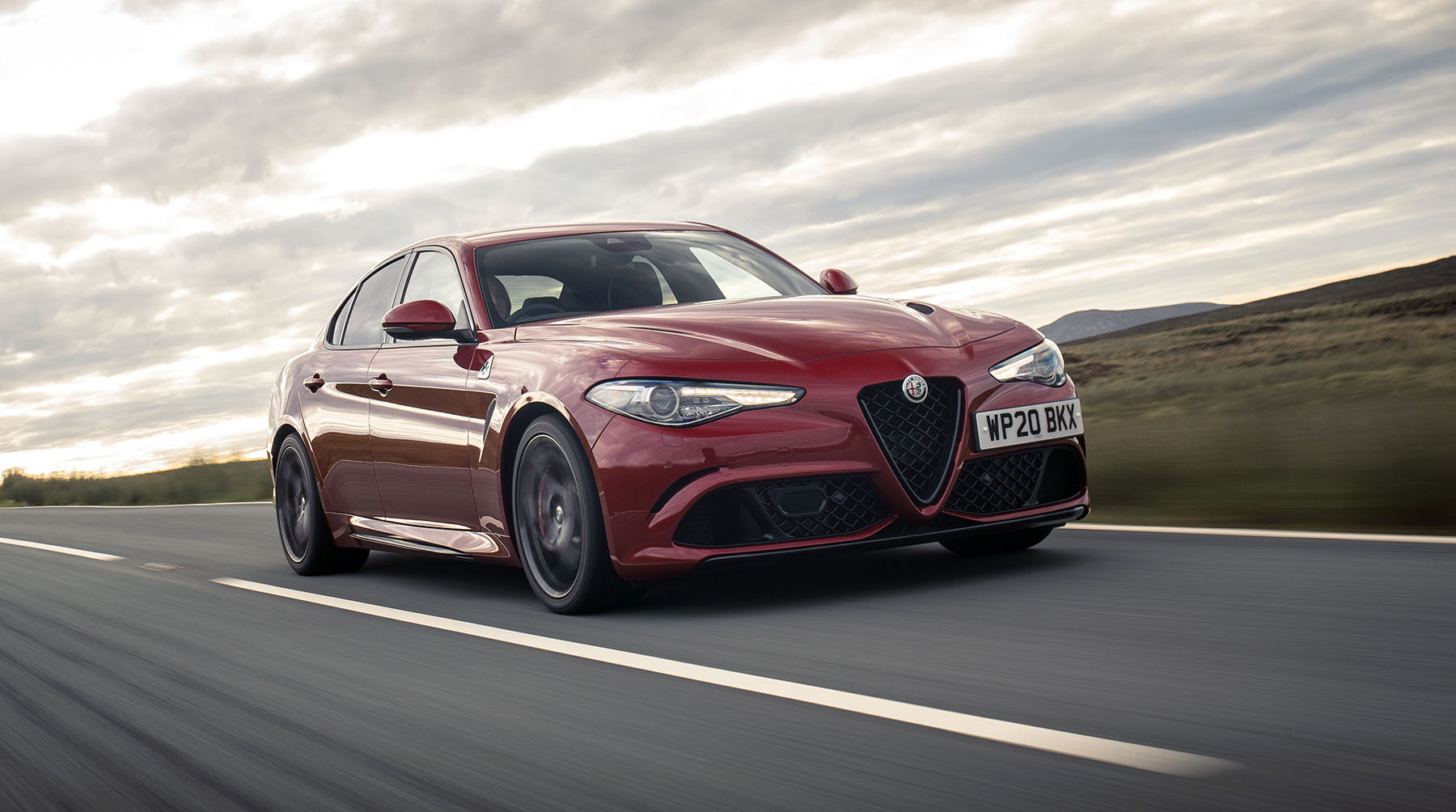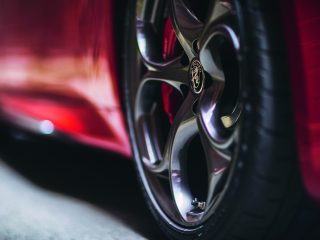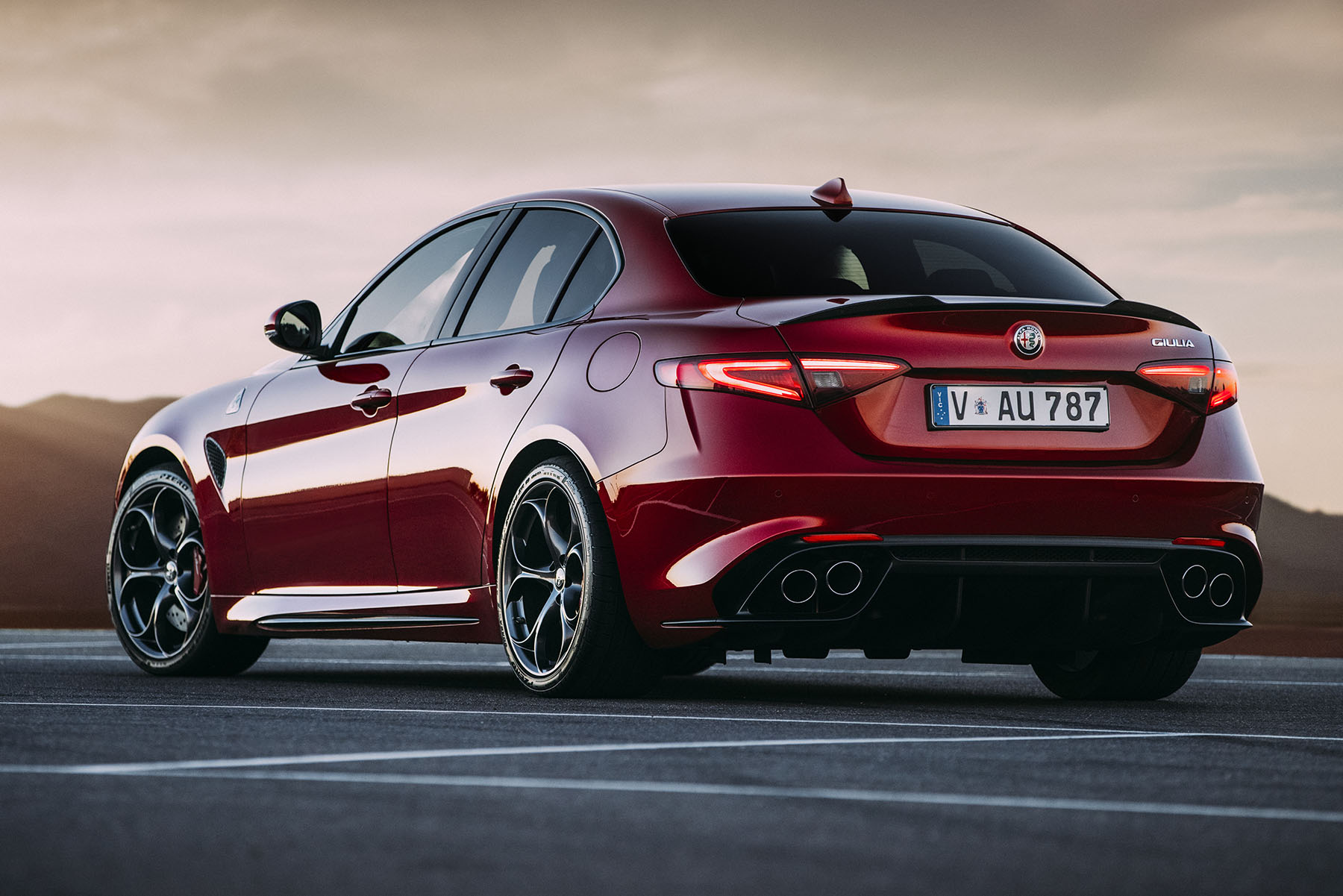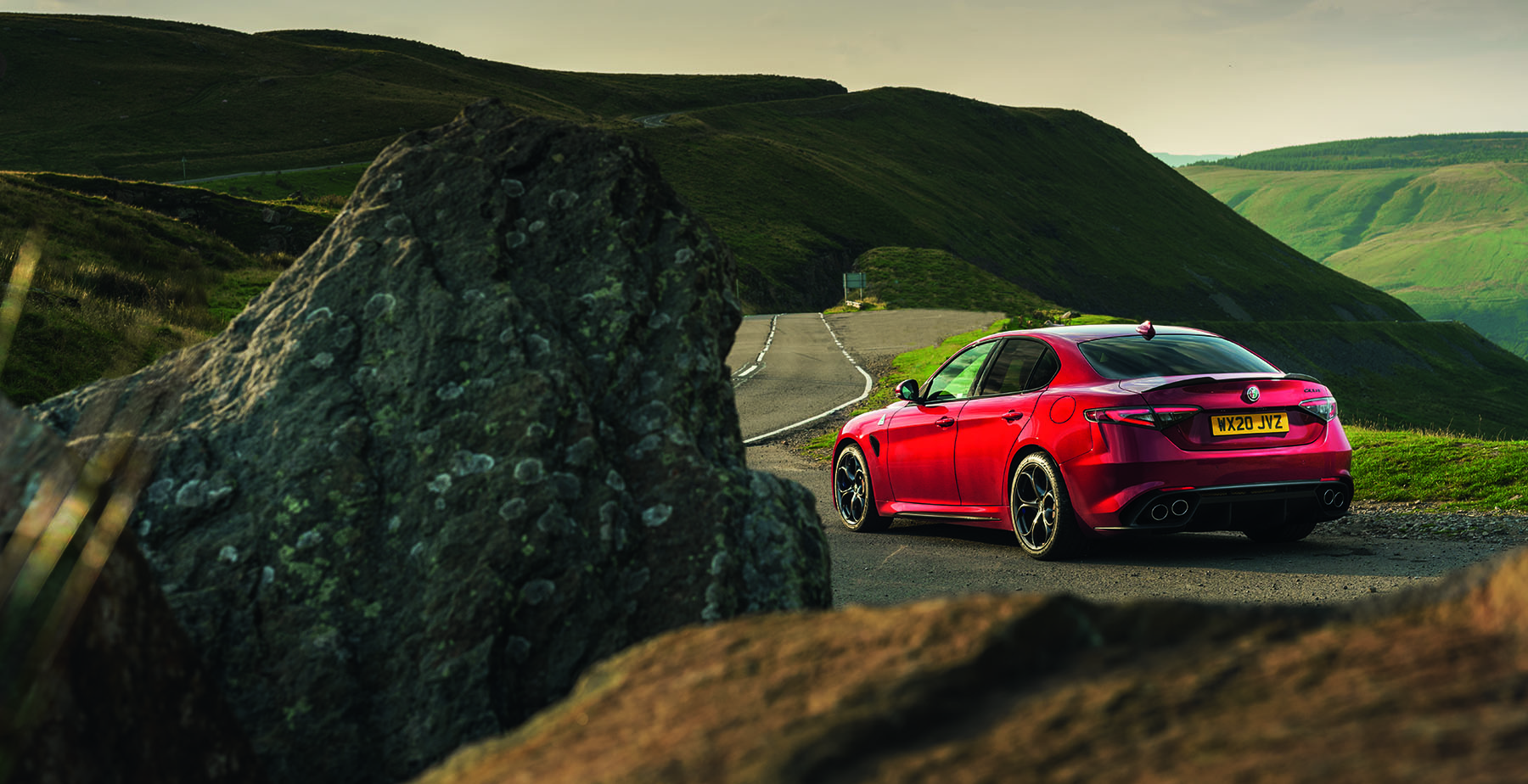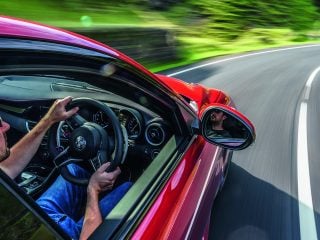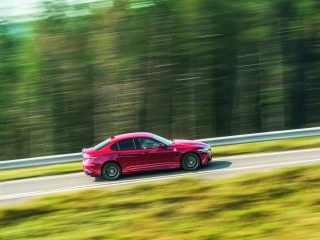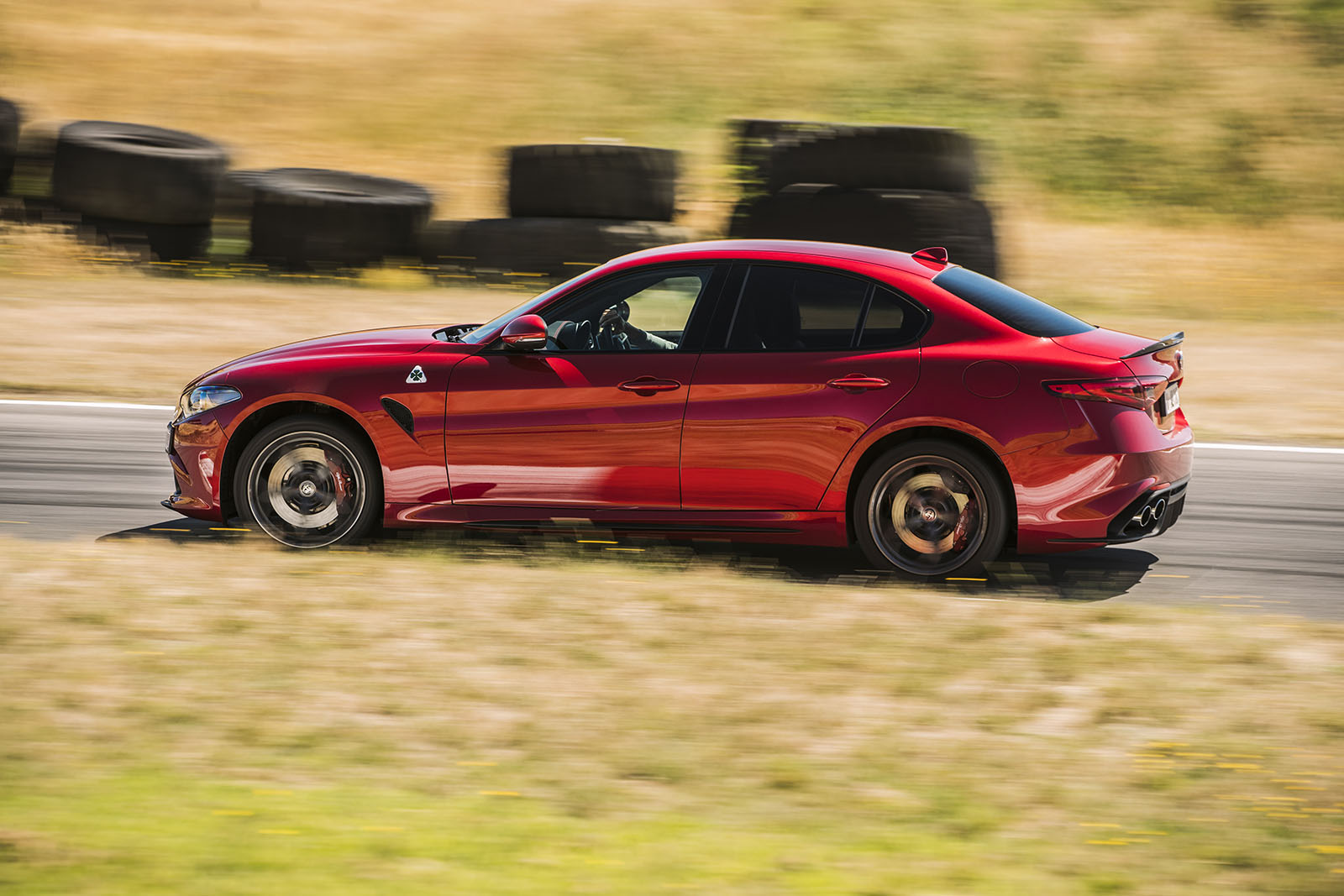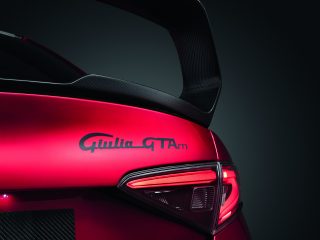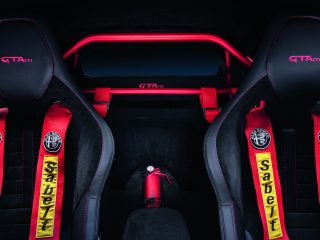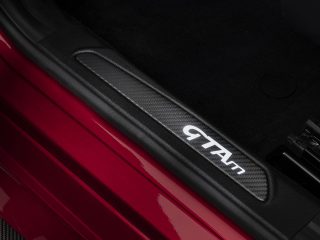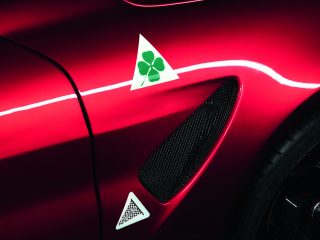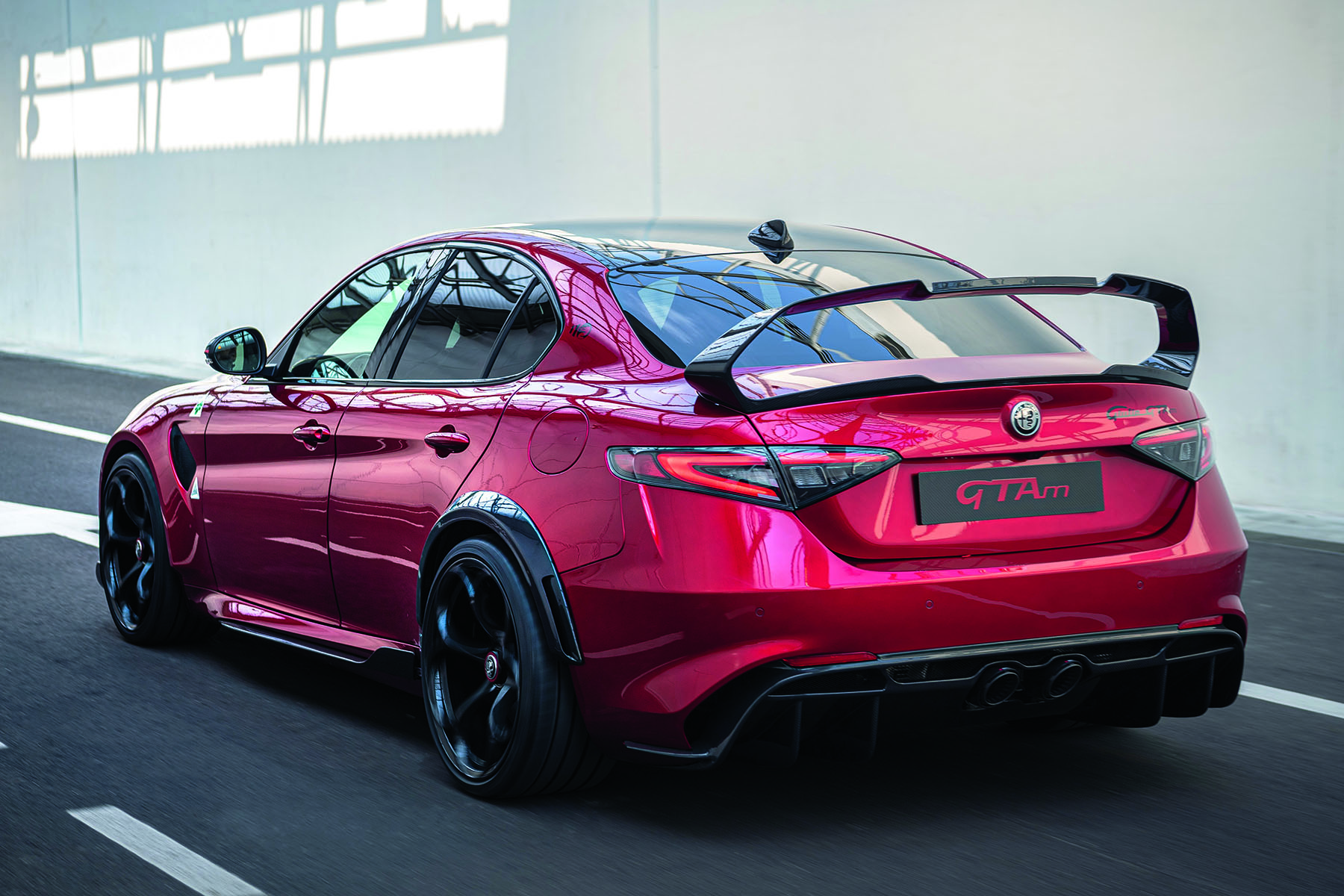The Alfa Romeo Giulia Quadrifoglio came from nowhere and re-ordered our world and the world is a better place because of it.
For the diehards, every Alfa Romeo is iconic. For the rest of us, they tend to be cars we’re happy to love and admire from a distance rather than own. This all changed in 2016 with the Giulia Quadrifoglio, Alfa’s very best for several generations and a car that, five years on, stills leads its field – and we say that knowing that the Alfa shares this field with the new-generation BMW M3. This is key to identifying future icons – if they excite and enthral half a decade on, with no excuses or caveats applied, you just know they’ll continue to do so for decades to come, too. They become cars you’ll go out of your way to drive over and over again. As with BMW’s E30 M3, the hot Giulia is a sports sedan you never turn down an opportunity to drive.
The Quadrifoglio not only delivered above and beyond expectations for an Alfa, but it moved the whole genre on, too. Its brilliance came out of nowhere. We hoped it would be as good as it is, but that it goes beyond those expectations tells you just how special a performance car it is.
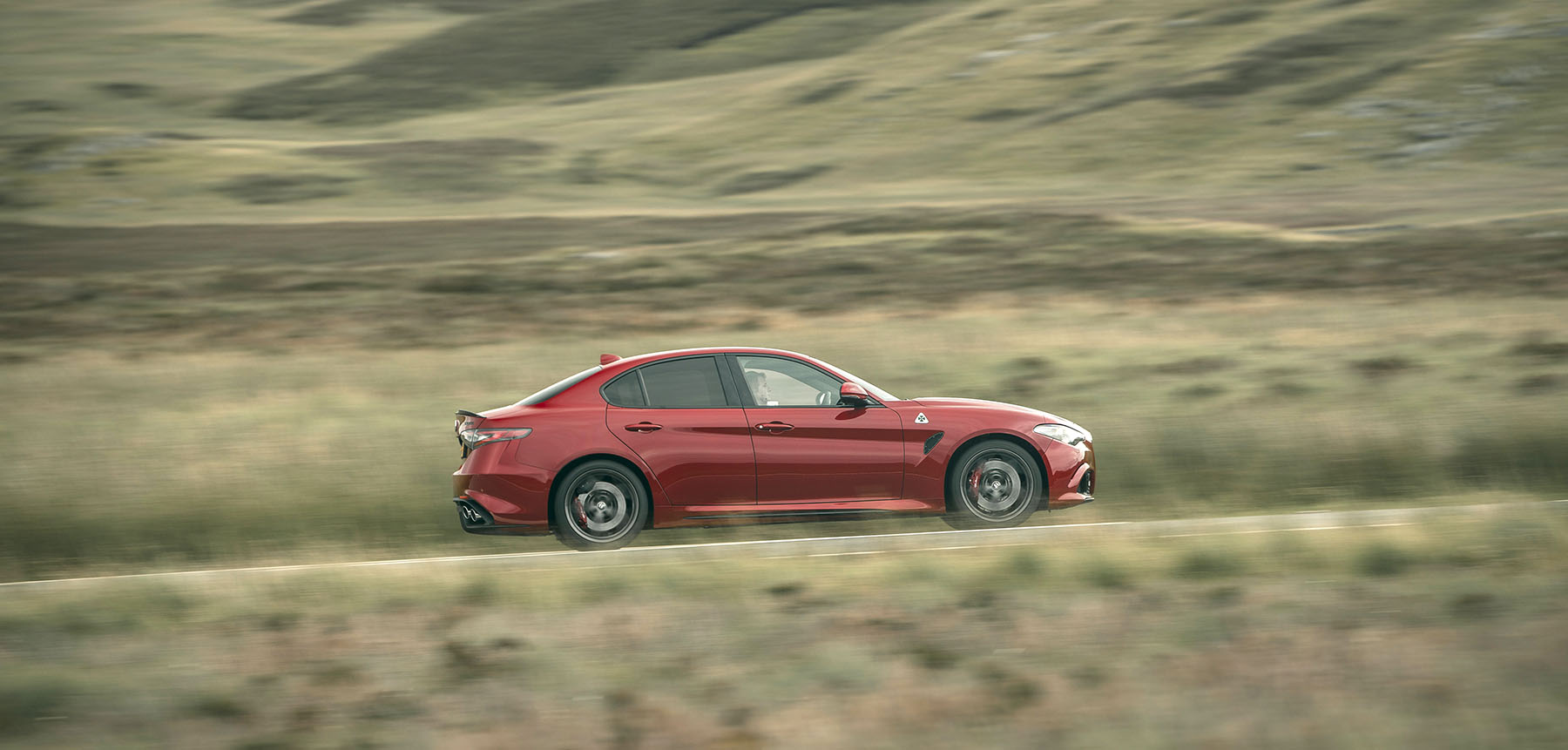 Light, compact and straightforward in approach, the Giulia focuses with total intent on what really counts in all great driver’s cars: peachy steering, dynamics that come alive when required but settle back when the kids are on board, and an engine that punches so far above its weight in terms of delivery and flexibility that rivals’ engines leave you cold. There’s an overall sense that the Quadrifoglio is a car engineered from the top to feed down to the lesser models in the range, rather than vice versa as is so often the case.
Light, compact and straightforward in approach, the Giulia focuses with total intent on what really counts in all great driver’s cars: peachy steering, dynamics that come alive when required but settle back when the kids are on board, and an engine that punches so far above its weight in terms of delivery and flexibility that rivals’ engines leave you cold. There’s an overall sense that the Quadrifoglio is a car engineered from the top to feed down to the lesser models in the range, rather than vice versa as is so often the case.
Like all iconic sports saloons, the appeal of the Quadrifoglio is tied up with the back-story of the men who developed it – in this case a team of dedicated engineers led by Roberto Fedeli, the same man who gave us the Ferrari F12 and 458 Speciale. Pedigrees come no better than that. And then there are the looks: even as the years roll by, you just know that it will continue to turn heads.
Knowing what’s to come when you press the starter button to wake that Ferrari-lite V6 and pull back on the shift paddles – themselves pure engineering artistry – will never fail to arouse a sense of anticipation that things are about to get fruity. Those carbon-shelled Sparco seats will be as welcoming in the next decade as they are today. The ergonomics will continue to plug you in to the action, hardwiring you to the car’s core. The bespoke super-soft Pirelli Corsa rubber won’t last long but will grip like a limpet mine, and with the rear diff no longer crying enough after three corners of a track, tomorrow’s drivers will continue to set the pace wherever they find themselves.
Today, some of the Alfa’s rivals are more powerful; newer ones most certainly will be. Many offer a more ‘premium’ experience, others are more accommodating; but few ignite the senses like the Alfa. It’s as keen and precise to drive as a pure-bred homologation special, more than worthy of comparison and inclusion in groups that also include the E30 M3. The Giulia is that good. And it always will be, because a true icon never fades.
2021 Alfa Romeo Giulia Quadrifoglio
Engine 2891cc V6, DOHC with VVT, 24-valve, electronic fuel injection and engine management Power 375kW @ 6500rpm Torque 600Nm @ 2500-5000rpm Transmission Eight-speed automatic, rear-wheel drive, limited-slip differential Steering Rack and pinion, semi-virtual steering axis Suspension Front and rear: double swing arm front, adaptive dampers, anti-roll bar, multi-link rear Brakes Discs, 360mm front, 350mm rear Weight 1620kg Top speed 307kph 0-100kph 3.9sec
 Beauty is a beast
Beauty is a beast
The refreshed Giulia Quadrifoglio features a host of technology changes, but the star remains the twin-turbocharged V6 and brilliantly balanced chassis.
It’s the proportions that first grab your attention but then your gaze is held by the details. The dash-to-axle ratio suggests that the Giulia can be nothing but rear-wheel drive, and the short overhangs at each end further add to the Quadrifoglio’s latent aggression. But unlike some of the Alfa’s German rivals, this isn’t an in-your-face sports sedan. Instead, it’s a car of details and stance.
For the recently facelifted Giulia models there are no mechanical changes, but then the Quadrifoglio didn’t really need messing with anyway. Instead, the changes are mostly cosmetic. There are three new paint colours, a bit of carbonfibre exterior tinsel has joined the options list, and the rear light clusters now have a darker tint and a new LED arrangement. The more extensive changes have taken place inside, with a new gear selector, a retrimmed steering wheel, a selection of performance-related menus for the infotainment display, and the adoption of modern lane-keeping and adaptive-cruise tech.
Like many of the great Alfas of old the Giulia Quadrifoglio is powered by a V6. Its 2.9-litre twin-turbocharged motor might not have the reputation, or emit the same acoustics, as Alfa’s legendary Busso engine but it shares plenty of DNA with the V8 found in the front of a Ferrari California T, Portofino, Roma or GTC Lusso. What more provenance do you need?
If you’re not impressed by the Marenello connection then the Alfa V6 has some notable figures to wow you instead. It puts out 375kW at 6500rpm, revs to 7000rpm and produces 600Nm between 1800 and 5500rpm. It isn’t the revviest engine, but it delivers its performance in such a linear and manageable manner that you don’t lament the opportunity to stretch the motor beyond the conservative limiter.
In Australia there is no choice of transmission: an eight-speed automatic gearbox is all you get. Yes, it’s that same ZF unit that BMW, Audi, Aston Martin, Jaguar, Land Rover and Maserati use. Left-hand drive cars can be ordered with a six-speed manual gearbox. The purists, such as us, might be left a little disappointed with not being given the option to select gears themselves.
If we’re being honest though, the automatic gearbox suits the Giulia better than the manual. We’re not just saying that to make ourselves feel better either; the notchy and long throw of the Giulia’s manual shift would take a lot of getting used to, whereas the fast, smooth shifts from the eight-speed auto are practically faultless.
Drive is then sent to the rear wheels via a carbonfibre propshaft and electronically controlled limited slip differential, that can not only vary the amount lock across the rear axle, but can actively send torque to a certain wheel to create torque vectoring, too.
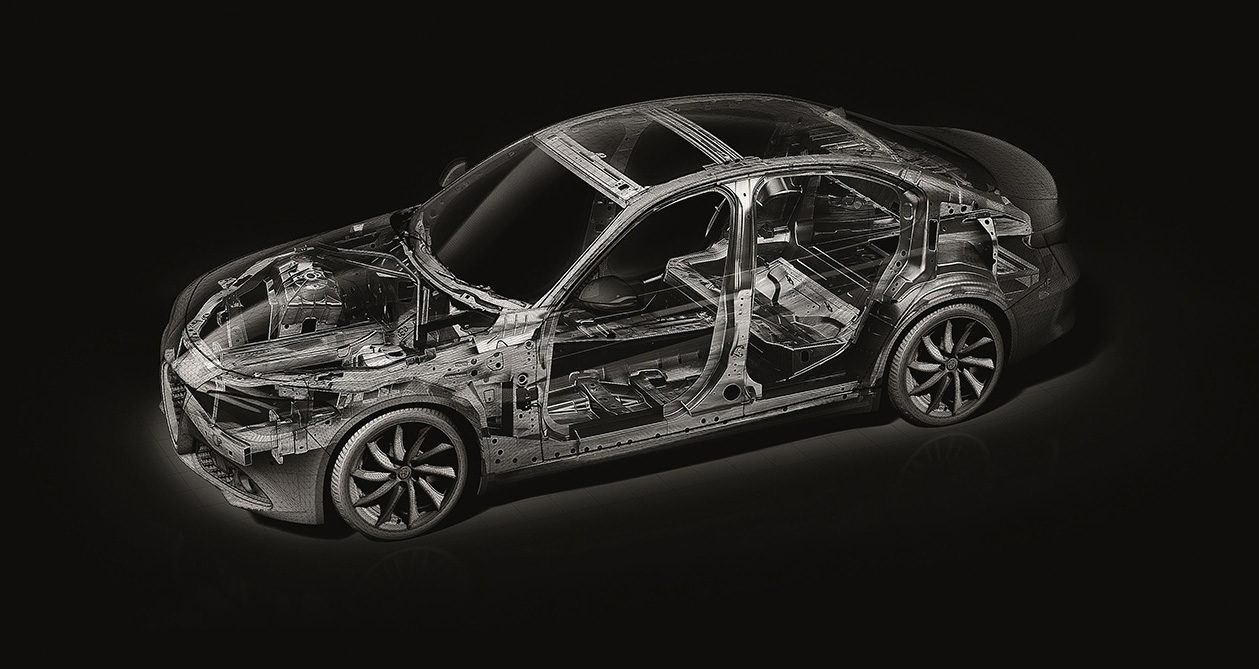 If the drivetrain is familiar, the reinvigorated interior and technology upgrades are worth recapping. Most obvious among the upgrades is the intuitive new 8.8-inch Multi-Touch display, featuring interactive widgets, full-screen maps, performance management features and a new touchscreen interface. The Alfa Romeo Giulia is now also equipped with an array of Advanced Driver Assistance Systems, including Traffic Sign Recognition with intelligent speed control, Active Blind Spot Assist and Driver Attention Assist. The Traffic Sign Recognition feature is a state-of-the-art, intelligent speed advisor that alerts drivers to changes in the legal speed limit. When the Active Cruise Control is activated, the speed is automatically adjusted via touching steering wheel controls.
If the drivetrain is familiar, the reinvigorated interior and technology upgrades are worth recapping. Most obvious among the upgrades is the intuitive new 8.8-inch Multi-Touch display, featuring interactive widgets, full-screen maps, performance management features and a new touchscreen interface. The Alfa Romeo Giulia is now also equipped with an array of Advanced Driver Assistance Systems, including Traffic Sign Recognition with intelligent speed control, Active Blind Spot Assist and Driver Attention Assist. The Traffic Sign Recognition feature is a state-of-the-art, intelligent speed advisor that alerts drivers to changes in the legal speed limit. When the Active Cruise Control is activated, the speed is automatically adjusted via touching steering wheel controls.
The Active Blind Spot Assist continuously monitors the rear blind spots on both sides of the vehicle, alerting the driver when attempting to cross into a lane that is already occupied. The system also delivers steering correction to aid in avoiding collisions. Driver Attention Assist monitors the movements of the vehicle via the Multi-Touch Display program, and encourages drivers to rest when drowsy via signals on the TFT display.
These upgrades aren’t ground-breaking, but they keep our favourite sports sedan at the top of the list.
 Green Pace
Green Pace
It was designed to compete with the BMW M3, and left with class honours – the Alfa Romeo Giulia Quadrifoglio is a masterpiece.
The Alfa Romeo Giulia Quadrifoglio has been a prominent figure within Automotive Daily since it burst out onto the scene in 2017, and for good reason as quite simply, the Giulia Quadrifoglio is a spectacular super sedan.
The ingredients on their own make for interesting reading: rear-wheel drive, a 375kW twin-turbo V6 engine, a (contextually) featherweight 1524kg kerb weight and an extremely focused chassis, but what really makes the Alfa shine is how each of these elements work together.
All of this excellence seemingly came from nowhere too, with Alfa Romeo enlisting a crack skunkworks-like team of designers and engineers to design almost every part of the Giulia from scratch without any real oversight – how Italian. Not only is the Quadrifoglio a great attempt at a super sedan, it leaves plenty of the German establishment with bloody noses.
Before you even start the Giulia Quadrifoglio you get the feeling that the team behind this car really cares about driving. You sit low, with your entire body cupped by the optional carbonfibre-backed Sparco seats. The huge range of adjustment on the steering column means you can pull the steering wheel into the exact position you want, too.
The starter button is positioned on the steering wheel while two long aluminium paddles, that follow the curve of the rim, are actually mounted on the column. Both feel very Ferrari-esque indeed. But that’s no surprise, because Alfa poached engineers from Ferrari to help develop the Giulia.
Another aspect of the Alfa that feels oh-so Ferrari is the steering. Just metres down a road you become aware that the Giulia has a very fast steering rack indeed, more than a little reminiscent of that found in the Ferrari 458 and 488, no less.
The perfect seating position and super fast steering instil a confidence in you that you could deal, react and drive through just about any situation with supreme accuracy; the conviction that you’d be able to tame a wild and unruly rear-wheel drive turbocharged car with ease.
But the Quadrifoglio isn’t the rabid, spiky animal its numbers might suggest. Don’t get us wrong, it’s certainly fast, but the way the performance is delivered from its 2.9-litre V6 is progressive and linear. The engine is muscular from low down and the car’s speed builds rapidly, but in perfect conjunction with the revs. There’s never that heart in your mouth moment when a huge wave of torque takes over, the revs spike and the car squirms in protest. Instead, it just powers forward in the manner you dictate.
There’s also a suppleness to the chassis which feels odd for a car with such sporting pretensions. The ride is rounded and plush, unlike the firm ride the Alfa’s rivals exhibit. It’s only as you being to really push the Giulia that softer chassis feels slightly lacking in body control, and a touch too much roll is apparent. But the Giulia’s DNA drive settings allow you to stiffen up the chassis as well as sharpening the throttle, adding weight to the steering and making the exhaust a bit louder. There are four DNA driving modes selected by a small rotary knob on the transmission tunnel. Advanced Efficiency (A) is the most fuel efficient and allows one bank of the V6’s cylinders to shut down.
Peel off onto quiet B-roads and the talent pool obviously runs deep. There aren’t many modern performance cars that feel as lightfooted as this. Even at a moderate pace it seems to dance around the road, responding keenly to economical movements of the steering and throttle, getting maximum benefit from minimal inputs. Quick steering can feel edgy in some cars, but the Giulia’s chassis seems perfectly in tune with the tight two turns lock-to-lock ratio, so it feels instantly natural, with just enough feedback to reassure the fingertips.
Next up is Natural (N), but Dynamic (D) and Race (yes, R) are where it gets interesting as the throttle, exhaust, gearshift, suspension and steering all ramp up the involvement.
The heavier steering is useful as it helps to slow your inputs and keep steering wheel movement to a minimum. The exhaust sounds bassier too, and you get either a satisfying crack at every upshift.
The biggest change is to the chassis, however. Dynamic firms up the dampers, but the car still feels compliant. Should you wish to have the noise, steering and throttle of Dynamic with the softest suspension, a button in the middle of the DNA dial allows you to relax the dampers.
Race mode is firmer still, but just as in Dynamic you can back the dampers off to a softer setting; not fully soft, but the same setting as the default in Dynamic. No matter which mode you’re in though, the suspension never feels unbearably stiff. Only the very bumpiest of roads makes Race feel less than ideal, but the slightly tighter body control is still preferred by some of the Automotive Daily team. Others prefer the more compliant modes, as it never really feels wayward or unrestrained. Either way, there’s a setting to suit everyone.
Race mode also disables the ESC and traction control – it’s the only way to deactivate the safety systems. This might suggest, as well as its name, that Race is a no-go on the road. That is not the case. The chassis and tyres provide so much grip you can still use a lot of throttle in the dry, while the engine’s predictable delivery means it’s easy to judge just how much throttle is necessary to maintain traction. If you’re more brutal with your right foot the tyres will relinquish their hold on the tarmac, but the fast steering means you can instantly react with the exact amount of corrective lock and control the car immediately.
Everything about the way the Giulia behaves is transparent, readable and dependable. As ludicrous as it might seem, the 375kW, turbocharged, rear-wheel drive Giulia is incredibly approachable.
 Don’t bother wrapping it
Don’t bother wrapping it
Stripped out 397kW Giulia GTA is Alfa Romeo’s 110th birthday present to itself.
Playing with a proven formula, especially one that involves the Giulia Quadrifoglio, is a dangerous game. The potential to get it spectacularly wrong far outweighs the opportunity to improve on the recipe, but we’re struggling to find much to disagree with when it comes to Alfa Romeo’s 110th birthday present to itself. A lighter, more powerful Giulia Quadrifoglio sounds a pretty compelling recipe to us.
Called the Giulia GTA, its 2.9-litre, twin-turbo V6 has been massaged and had an Akrapovic titanium exhaust fitted, resulting in an additional 22kW being produced over the standard Quadrifoglio’s 375kW, while weight has been reduced by 100kg and a raft of new aerodynamic add-ons have been fitted. And for those who enjoy their four-door super sedan without any rear seats, there is the more extreme Giulia GTAm variant.
The GTA’s weight saving is courtesy of plenty of carbonfibre. In addition to the regular Quadrifoglio’s carbon bonnet and propshaft, the roof, front bumper (with its larger air intakes), wheelarches, rear arch extensions and rear diffuser are all now produced from the lighter material. So too is the new design of side skirt, a revised active front splitter and new rear boot spoiler, the latter two both considerably larger on the GTAm – both drawing inspiration from the legendary 155 DTm race car.
Alfa Romeo Racing drivers Kimi Räikkönen and Antonio Giovinazzi have both recently found themselves behind the wheel of the upcoming Giulia GTA as it enters its final stages of development. Alfa’s resident F1 drivers took to the wheel at the FCA’s famous Balocco Proving Ground in Italy where Sauber Engineering, the racing company behind the Alfa Romeo Racing team branding, has been honing the model’s aggressive aerodynamic devices. This partnership has given Alfa Romeo access to Sauber’s F1 wind tunnel in Hinwil, Switzerland, resulting in this impressive aerodynamic performance – the bewinged GTAm is said to deliver twice the downforce of the GTA, and three times that of an ordinary Giulia Quadrofoglio.
Beneath the lighter body are new springs and dampers, lowering the ride height and increasing roll stiffness, and there’s new suspension bushing, too. Both the front and rear tracks are 50mm wider and those 20-inch wheels feature centre-lock fixings.
Inside, both models are awash with Alcantara covering the dash, door panels and the seats. For the GTAm the rear seats get ditched, replaced by a roll-cage and somewhere to store your crash helmet, while the conventional door panels front and rear are swapped for simpler, more motorsport-inspired items that include a length of material in place of the plastic release handles. The GTAm also features Lexan polycarbonate side and rear windows in place of the standard glass. There’s no confirmation yet that the model will be available in Australia, though the brand has it at the top of its wish list.


